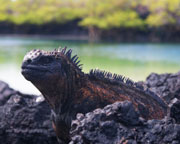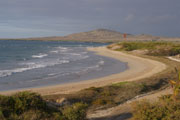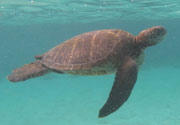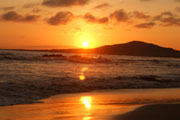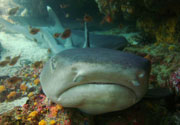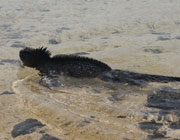| Wildlife |
The west coast of Isabela usually provides the best opportunities for seeing whales in the Galapagos. Two ocean currents collide here: the Humboldt and the Cromwell (also known as the Equatorial Counter Current), creating the coldest water temperatures. Marine mammals seen in this area can include sperm whales, pilot whales, orcas and even a rare sighting of a blue whale. Several of our Wildlife Yacht Safaris reach these areas, so if this is an area you would like to visit, please contact us for advice. 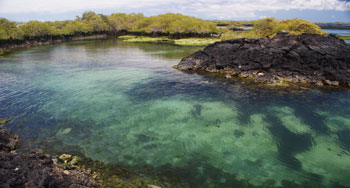
Elizabeth Bay is the deepest inlet into the west coast of Isabela - a place where we make a wet landing to go onshore. This is where we can find the largest concentration of Galapagos penguins in the Galapagos, which we can spot along the shorelines of the Mariela Islets. Galapagos Hawks are often spotted circling overhead in this area, while schools of pompanos and dorados can be seen when snorkelling below. This is also a great spot for seeing Black or Pacific Green Sea Turtles, which are most commonly spotted from November to February. The subspecies Celonia mydas agassizi which is found in the Galapagos is sometimes considered a distinct species.
A trip along the Bolivar Channel will lead to Tagus Cove, which historically speaking was a popular anchoring site for pirates and whalers. It is also a good for seeing dolphins and whales.
For divers, our main focus by liveaboard is Cape Marshall (Cabo Marshal in Spanish). Here we find cleaning stations for Giant Manta Rays, around seamounts whose peaks are no more than 6m below the surface. Volcanic ash runoff can reduce visibility here which means when you do see a manta, you are close enough to take in its full scale. Sometimes we can also see huge schools of Black Striped Salema which are a particular favourite of fur seals and sealions - something else you can enjoy with some playful encounters along the coast here.
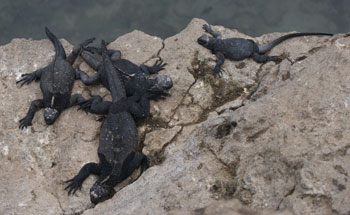
One of the best dive sites of the Galapagos is that of Punta Vicente Roca: a label which can be attributed to a combination of cold water currents and the protective nature of the cove formation. The dive site lies beneath a pretty cove, which is itself lies beneath the eroded remains of a volcanic cone. The underwater surroundings of the dive site mirror the landscape of hills and deep crevices above. The walls are decorated with an array of corals and overall it is an extremely colourful site, although the waters here can at times be breathtakingly cold. Such marine life that is likely to be seen here, includes the Galapagos shark, Galapagos rock bass, gold-rimmed surgeonfish, the unusual harlequin wrasse and sailfin grouper. Huge schools of Black Striped Salemas can also often be encountered here.
Photographs kindly provided by Ralph Pannell & Eric Jan Rijkhorst
The Beagle - Mary Anne - Cachalote - Sagitta - Amazonia - Samba - Beluga - Galaxy - Princess Grace - Aida Maria - Eden - Evolution - Eclipse - Grand Odyssey - Journey I - Eric - Flamingo - Letty - Odyssey - Athala - Nemo I - Nemo II - Diamante - Alta - Lammer Law - Rachel - La Pinta - Humboldt Explorer - Parranda - Isabela (Albemarie) - Santa Cruz (Indefatigable) - San Cristobal (Chatham) - Baltra (South Seymour) - North Seymour (Seymour Norte) - Fernandina (Narborough) - Española (Hood) - Genovesa (Tower) - Bartolomé (Bartolemew) - Santiago (San Salvador or James) - Santa María (Floreana or Charles) - Marchena (Blindoe) - Mosquera - Plaza Sur (South Plaza) - Pinta (Abingdon) - Pinzón (Duncan) - Santa Fé (Barrington) - Rabida (Jervis) - Daphne
Galapagos wildlife birdlife birdwatching & natural history holidays - Sail Galapagos islands - expedition cruise vacation holiday - Ecuador responsible travel - Amazon - Andes - Quito - Guayaquil - sky aggressor - Dive Snorkel Diving & Snorkelling - kayak westsuit - Latin & South America journey - Specialist Guided Photography holidays workshops - Charles Darwin Research Station - Galapagos Conservation Trust - Rainforest Concern




